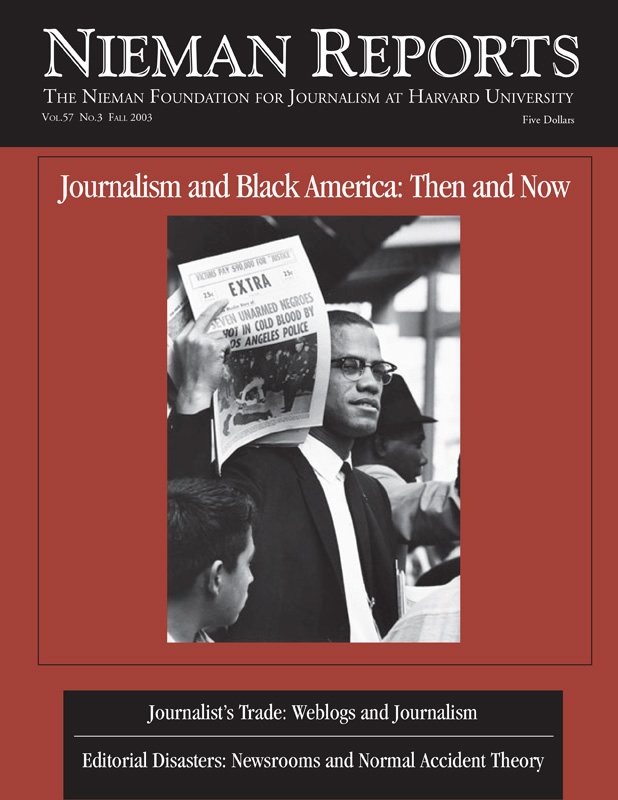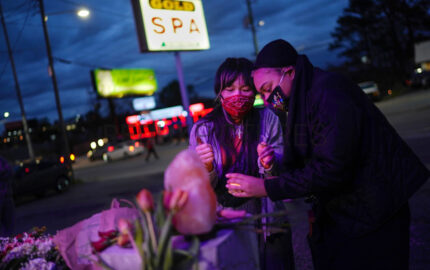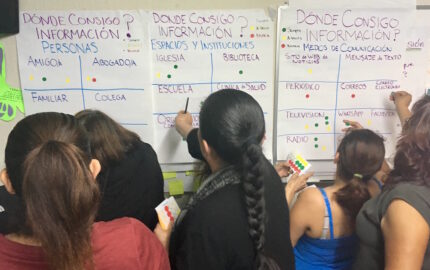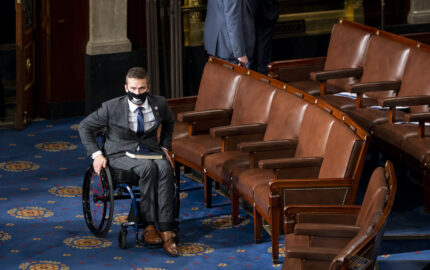The New York Times scandal involving reporter Jayson Blair left many victims: The readers were lied to. The staff was humiliated. The two top editors were ousted. The paper’s reputation was tarnished. Journalism itself was scarred.
But the entire debacle’s most unfortunate victim may be the good name of diversity in American newsrooms. Or was it?
Early on in the drama, The Washington Post’s Howard Kurtz made the now-laughable proclamation on CNN: “I wonder if a middle-aged hack would have gotten away with 50 mistakes and still be at that job?” (The answer, by the way, is yes.)
Then blowhard conservatives and frustrated newsroom left-behinds began to pile on, calling Blair the poster child for what’s wrong with newsroom diversity, claiming that it has taken over the newsroom and lowered standards.
But just when Fox News was ready to go live (cue the whoosh sound effect), reality set in. People began to look at the facts, and journalists started to form clearer impressions about the value and impact of diversity in newsrooms. And the truth hurt.
The Reality Behind the Numbers
In an industry already struggling to meet its meager goals of reflecting the racial and ethnic makeup of their communities by 2025, efforts to recruit, hire and retain journalists of color have been plodding along, at best. Nearly nine of 10 newsroom professionals in America are white—and most of them white males. People of color make up just one-tenth of newsroom leaders. And the needle has barely moved in the past decade.
If diversity is taking over the newsroom, I guess most folks didn’t get the memo. Three years past an initial industry target for local parity in newsroom staffing nationwide—editors had performed so pathetically they extended the deadline to 2025—the industry still misses the mark.
Meanwhile, the nation grows rapidly more diverse and complex, with people of color making up 31 percent of the U.S. population. And that figure will only rise, according to the census bureau. In states such as California and Texas, and cities like Miami and Phoenix, those so-called “minorities” are in fact the majority. Within a generation, the rest of America will likely look like those communities. And unless things change dramatically, newsrooms will still be ill-equipped to cover this new America.
Why is this important? Too many newspapers still cannot fully cover the richness and complexity of their communities because their staffs come from a limited perspective. We are unable to regularly listen to those in the shadows and too often incapable of hearing voices different from our own. We, therefore, are telling our readers an incomplete, inaccurate story. And, in the process, we are practicing bad journalism.
Whether it is coverage of the local Muslim community leading up to the war, or getting inside a Vietnamese-American neighborhood in everyday stories, our newsrooms too often miss nuances in coverage or miss entire stories completely because we don’t have staffs diverse enough to “get it.” Or we miss fresh angles on the routine stories because the few staffers of color there are have been pigeonholed into doing stories on Cinco de Mayo or Black History Month. They don’t get to cover the drama on the city council or developments in Tel Aviv.
Many newsrooms still look like a 1950’s “Leave It to Beaver” image of America. Sure, some have progressed to a 1970’s picture of black and white, allowing George Jefferson to coexist with Archie Bunker. But only a handful of U.S. papers, less than three percent, reflect the real America in 2003, “In Living Color.”
It’s time for serious action, but only a few editors have demonstrated the guts or ability to do what it takes.
Failing Grades at Big and Small Papers
According to a 2003 diversity survey, the overwhelming majority of American newspapers—some 97 percent of those that responded—are miles away from having staffing that reflects the racial richness of their local communities. For instance, The Miami Herald, in a market that is 65 percent minority, might have a staff of about 45 percent people of color—the highest percentage of any major paper in America. But the only slightly smaller Boston Herald, in a market that is almost 20 percent minority, reported only five percent of its staff as people of color.
And to make matters worse, 40 percent of all American papers still have no—zero—journalists of color working for them. That means that more than four million readers—more than the circulation of USA Today, The New York Times, and The Washington Post combined—do not read the work of people of color in their newspapers. Papers such as The (Everett, Wash.) Herald, circulation 50,506, and the Lancaster (Pa.) New Era, circulation 45,019, as well as companies like Liberty, Ogden and Community Newspaper Holdings top this hall of shame.
The audit, conducted annually by the American Society of Newspaper Editors (ASNE), shows that nearly 500 papers failed to respond at all, including such big names as the New York Post and the Chicago Sun-Times. Of those that did respond, their newsrooms have 12.53 percent professionals of color (Asians, blacks, Latinos or Native Americans). That figure is well off ASNE’s own interim 2003 target of 15.55 percent average nationwide and nowhere near the goal of parity with the rest of America by 2025. By that year, the national population is expected to be nearly 40 percent people of color.
Looking at average hiring and attrition rates in American newsrooms, to meet the 2025 parity goal editors will need to make virtually every new hire during the next two decades a person of color, just to catch up.
And which editors have the will and the guts to do that?
A Few Success Stories
While radical action like this may be inconceivable for most editors, a quiet few have started taking dramatic steps and should serve as examples.
For instance, during the recent economic downturn, hiring has been scarce in most newsrooms. At The Washington Post, hiring has been limited as well, but editors were tired of seeing their diversity efforts stall until the economy rebounded. So according to Post deputy managing editor, Milton Coleman, the leadership focused its efforts especially on strong journalists of color.
The impact: At the Post through the end of 2002—and during the worst economy in recent history—nearly 50 percent of all new hires have been people of color.
On the other side of the country, journalists in Denver were tired of seeing the Latino community underrepresented or misrepresented in local papers. So editors at the Rocky Mountain News and the E.W. Scripps Company this spring teamed up with The National Association of Hispanic Journalists (NAHJ) to be the test site for NAHJ’s Parity Project. In this project, NAHJ pairs community members with newsroom leaders to match local staffing and reporting patterns with community impressions of coverage and look for ways to bring the two closer. Nationwide, the goal is to identify cities where Latinos are underrepresented in local newsrooms but make up a significant portion of the population and look at the impact that divergence has on coverage.
The impact: At a recent roundtable in Denver, nearly every senior editor at the Rocky Mountain News heard firsthand from Latino community leaders about their impressions of how their paper covers—or doesn’t cover—their community. One community member complained about the narrow coverage of Cinco de Mayo; he felt the paper focused too much on young Latinos cruising the streets. Another person said the paper was too dense, distant and impenetrable. After listening to this feedback, editors pledged to open up the newsroom, listen more to these and other communities, and increase efforts to diversify their staff and their coverage.
Meanwhile David Yarnold, now editor of the San Jose Mercury News, chairman of the diversity committee for ASNE, and recipient of the Ida B. Wells Award from the National Association of Black Journalists (NABJ), was tired of hearing reporters say that they couldn’t find diverse sources for their stories and photos. So he, at that time executive editor, challenged reporters to quickly and measurably go out in the community, find new sources, take them out to lunch if needed, and look to expand their diverse contacts. And not only did he offer to pay for the lunches, he gave every reporter a full week off their beats to do nothing but expand their source lists.
The impact: More than 100 reporters have significantly expanded their lists and are now including women and people of color previously absent from the Mercury News. Yarnold said one reporter spent her week talking to dozens of new leads and came away with about 30 new people or groups to use as sources.
And national organizations are not being left out. The Freedom Forum, tired of hearing editors at smaller newspapers complain they can’t find any young, talented journalists of color willing to work in small towns for little pay, has teamed up with ASNE and The Associated Press managing editors to help place young journalists at newspapers under 75,000 circulation.
The impact: Nearly 50 young journalists of color—including five provided by the NABJ—are now or will be working at small and medium-sized newsrooms around the country, supported by a $20,000 salary supplement from the Freedom Forum.
While all these efforts are exciting and laudatory, it will take 10 times this activity level to even come close to hitting the parity goals for staffing and coverage that our industry has pledged. But if editors continue our miserable level of progress, a new generation of leaders will, 22 years from now, still be talking about the problem, scratching their heads, and wondering what to do.
Diversity hasn’t “taken over” American newsrooms, as some claim it has. Truth is, it is barely showing up. Editors should be tired of talking. It is time to act.
Bryan Monroe, a 2003 Nieman Fellow, is assistant vice president for news at Knight Ridder. He is also vice president/print of the National Association of Black Journalists and is on the board of Unity: Journalists of Color, Inc.
But the entire debacle’s most unfortunate victim may be the good name of diversity in American newsrooms. Or was it?
Early on in the drama, The Washington Post’s Howard Kurtz made the now-laughable proclamation on CNN: “I wonder if a middle-aged hack would have gotten away with 50 mistakes and still be at that job?” (The answer, by the way, is yes.)
Then blowhard conservatives and frustrated newsroom left-behinds began to pile on, calling Blair the poster child for what’s wrong with newsroom diversity, claiming that it has taken over the newsroom and lowered standards.
But just when Fox News was ready to go live (cue the whoosh sound effect), reality set in. People began to look at the facts, and journalists started to form clearer impressions about the value and impact of diversity in newsrooms. And the truth hurt.
The Reality Behind the Numbers
In an industry already struggling to meet its meager goals of reflecting the racial and ethnic makeup of their communities by 2025, efforts to recruit, hire and retain journalists of color have been plodding along, at best. Nearly nine of 10 newsroom professionals in America are white—and most of them white males. People of color make up just one-tenth of newsroom leaders. And the needle has barely moved in the past decade.
If diversity is taking over the newsroom, I guess most folks didn’t get the memo. Three years past an initial industry target for local parity in newsroom staffing nationwide—editors had performed so pathetically they extended the deadline to 2025—the industry still misses the mark.
Meanwhile, the nation grows rapidly more diverse and complex, with people of color making up 31 percent of the U.S. population. And that figure will only rise, according to the census bureau. In states such as California and Texas, and cities like Miami and Phoenix, those so-called “minorities” are in fact the majority. Within a generation, the rest of America will likely look like those communities. And unless things change dramatically, newsrooms will still be ill-equipped to cover this new America.
Why is this important? Too many newspapers still cannot fully cover the richness and complexity of their communities because their staffs come from a limited perspective. We are unable to regularly listen to those in the shadows and too often incapable of hearing voices different from our own. We, therefore, are telling our readers an incomplete, inaccurate story. And, in the process, we are practicing bad journalism.
Whether it is coverage of the local Muslim community leading up to the war, or getting inside a Vietnamese-American neighborhood in everyday stories, our newsrooms too often miss nuances in coverage or miss entire stories completely because we don’t have staffs diverse enough to “get it.” Or we miss fresh angles on the routine stories because the few staffers of color there are have been pigeonholed into doing stories on Cinco de Mayo or Black History Month. They don’t get to cover the drama on the city council or developments in Tel Aviv.
Many newsrooms still look like a 1950’s “Leave It to Beaver” image of America. Sure, some have progressed to a 1970’s picture of black and white, allowing George Jefferson to coexist with Archie Bunker. But only a handful of U.S. papers, less than three percent, reflect the real America in 2003, “In Living Color.”
It’s time for serious action, but only a few editors have demonstrated the guts or ability to do what it takes.
Failing Grades at Big and Small Papers
According to a 2003 diversity survey, the overwhelming majority of American newspapers—some 97 percent of those that responded—are miles away from having staffing that reflects the racial richness of their local communities. For instance, The Miami Herald, in a market that is 65 percent minority, might have a staff of about 45 percent people of color—the highest percentage of any major paper in America. But the only slightly smaller Boston Herald, in a market that is almost 20 percent minority, reported only five percent of its staff as people of color.
And to make matters worse, 40 percent of all American papers still have no—zero—journalists of color working for them. That means that more than four million readers—more than the circulation of USA Today, The New York Times, and The Washington Post combined—do not read the work of people of color in their newspapers. Papers such as The (Everett, Wash.) Herald, circulation 50,506, and the Lancaster (Pa.) New Era, circulation 45,019, as well as companies like Liberty, Ogden and Community Newspaper Holdings top this hall of shame.
The audit, conducted annually by the American Society of Newspaper Editors (ASNE), shows that nearly 500 papers failed to respond at all, including such big names as the New York Post and the Chicago Sun-Times. Of those that did respond, their newsrooms have 12.53 percent professionals of color (Asians, blacks, Latinos or Native Americans). That figure is well off ASNE’s own interim 2003 target of 15.55 percent average nationwide and nowhere near the goal of parity with the rest of America by 2025. By that year, the national population is expected to be nearly 40 percent people of color.
Looking at average hiring and attrition rates in American newsrooms, to meet the 2025 parity goal editors will need to make virtually every new hire during the next two decades a person of color, just to catch up.
And which editors have the will and the guts to do that?
A Few Success Stories
While radical action like this may be inconceivable for most editors, a quiet few have started taking dramatic steps and should serve as examples.
For instance, during the recent economic downturn, hiring has been scarce in most newsrooms. At The Washington Post, hiring has been limited as well, but editors were tired of seeing their diversity efforts stall until the economy rebounded. So according to Post deputy managing editor, Milton Coleman, the leadership focused its efforts especially on strong journalists of color.
The impact: At the Post through the end of 2002—and during the worst economy in recent history—nearly 50 percent of all new hires have been people of color.
On the other side of the country, journalists in Denver were tired of seeing the Latino community underrepresented or misrepresented in local papers. So editors at the Rocky Mountain News and the E.W. Scripps Company this spring teamed up with The National Association of Hispanic Journalists (NAHJ) to be the test site for NAHJ’s Parity Project. In this project, NAHJ pairs community members with newsroom leaders to match local staffing and reporting patterns with community impressions of coverage and look for ways to bring the two closer. Nationwide, the goal is to identify cities where Latinos are underrepresented in local newsrooms but make up a significant portion of the population and look at the impact that divergence has on coverage.
The impact: At a recent roundtable in Denver, nearly every senior editor at the Rocky Mountain News heard firsthand from Latino community leaders about their impressions of how their paper covers—or doesn’t cover—their community. One community member complained about the narrow coverage of Cinco de Mayo; he felt the paper focused too much on young Latinos cruising the streets. Another person said the paper was too dense, distant and impenetrable. After listening to this feedback, editors pledged to open up the newsroom, listen more to these and other communities, and increase efforts to diversify their staff and their coverage.
Meanwhile David Yarnold, now editor of the San Jose Mercury News, chairman of the diversity committee for ASNE, and recipient of the Ida B. Wells Award from the National Association of Black Journalists (NABJ), was tired of hearing reporters say that they couldn’t find diverse sources for their stories and photos. So he, at that time executive editor, challenged reporters to quickly and measurably go out in the community, find new sources, take them out to lunch if needed, and look to expand their diverse contacts. And not only did he offer to pay for the lunches, he gave every reporter a full week off their beats to do nothing but expand their source lists.
The impact: More than 100 reporters have significantly expanded their lists and are now including women and people of color previously absent from the Mercury News. Yarnold said one reporter spent her week talking to dozens of new leads and came away with about 30 new people or groups to use as sources.
And national organizations are not being left out. The Freedom Forum, tired of hearing editors at smaller newspapers complain they can’t find any young, talented journalists of color willing to work in small towns for little pay, has teamed up with ASNE and The Associated Press managing editors to help place young journalists at newspapers under 75,000 circulation.
The impact: Nearly 50 young journalists of color—including five provided by the NABJ—are now or will be working at small and medium-sized newsrooms around the country, supported by a $20,000 salary supplement from the Freedom Forum.
While all these efforts are exciting and laudatory, it will take 10 times this activity level to even come close to hitting the parity goals for staffing and coverage that our industry has pledged. But if editors continue our miserable level of progress, a new generation of leaders will, 22 years from now, still be talking about the problem, scratching their heads, and wondering what to do.
Diversity hasn’t “taken over” American newsrooms, as some claim it has. Truth is, it is barely showing up. Editors should be tired of talking. It is time to act.
Bryan Monroe, a 2003 Nieman Fellow, is assistant vice president for news at Knight Ridder. He is also vice president/print of the National Association of Black Journalists and is on the board of Unity: Journalists of Color, Inc.



